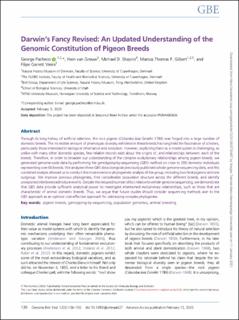| dc.contributor.author | Pacheco, George | |
| dc.contributor.author | Van Grouw, Hein | |
| dc.contributor.author | Shapiro, Michael D. | |
| dc.contributor.author | Gilbert, Marcus Thomas Pius | |
| dc.contributor.author | Vieira, Filipe G. | |
| dc.date.accessioned | 2021-01-12T15:06:10Z | |
| dc.date.available | 2021-01-12T15:06:10Z | |
| dc.date.created | 2021-01-05T18:31:07Z | |
| dc.date.issued | 2020 | |
| dc.identifier.citation | Genome Biology and Evolution. 2020, 12 (3), 136-150. | en_US |
| dc.identifier.issn | 1759-6653 | |
| dc.identifier.uri | https://hdl.handle.net/11250/2722634 | |
| dc.description.abstract | Through its long history of artificial selection, the rock pigeon (Columba livia Gmelin 1789) was forged into a large number of domestic breeds. The incredible amount of phenotypic diversity exhibited in these breeds has long held the fascination of scholars, particularly those interested in biological inheritance and evolution. However, exploiting them as a model system is challenging, as unlike with many other domestic species, few reliable records exist about the origins of, and relationships between, each of the breeds. Therefore, in order to broaden our understanding of the complex evolutionary relationships among pigeon breeds, we generated genome-wide data by performing the genotyping-by-sequencing (GBS) method on close to 200 domestic individuals representing over 60 breeds. We analyzed these GBS data alongside previously published whole-genome sequencing data, and this combined analysis allowed us to conduct the most extensive phylogenetic analysis of the group, including two feral pigeons and one outgroup. We improve previous phylogenies, find considerable population structure across the different breeds, and identify unreported interbreed admixture events. Despite the reduced number of loci relative to whole-genome sequencing, we demonstrate that GBS data provide sufficient analytical power to investigate intertwined evolutionary relationships, such as those that are characteristic of animal domestic breeds. Thus, we argue that future studies should consider sequencing methods akin to the GBS approach as an optimal cost-effective approach for addressing complex phylogenies. | en_US |
| dc.language.iso | eng | en_US |
| dc.publisher | Oxford University Press | en_US |
| dc.rights | Navngivelse 4.0 Internasjonal | * |
| dc.rights.uri | http://creativecommons.org/licenses/by/4.0/deed.no | * |
| dc.title | Darwin's Fancy Revised: An Updated Understanding of the Genomic Constitution of Pigeon Breeds | en_US |
| dc.type | Peer reviewed | en_US |
| dc.type | Journal article | en_US |
| dc.description.version | publishedVersion | en_US |
| dc.source.pagenumber | 136-150 | en_US |
| dc.source.volume | 12 | en_US |
| dc.source.journal | Genome Biology and Evolution | en_US |
| dc.source.issue | 3 | en_US |
| dc.identifier.doi | 10.1093/gbe/evaa027 | |
| dc.identifier.cristin | 1865969 | |
| dc.description.localcode | © The Author(s) 2020. Published by Oxford University Press on behalf of the Society for Molecular Biology and Evolution. This is an Open Access article distributed under the terms of the Creative Commons Attribution License (http://creativecommons.org/licenses/by/4.0/), which permits unrestricted reuse, distribution, and reproduction in any medium, provided the original work is properly cited. | en_US |
| cristin.ispublished | true | |
| cristin.fulltext | original | |
| cristin.qualitycode | 1 | |

